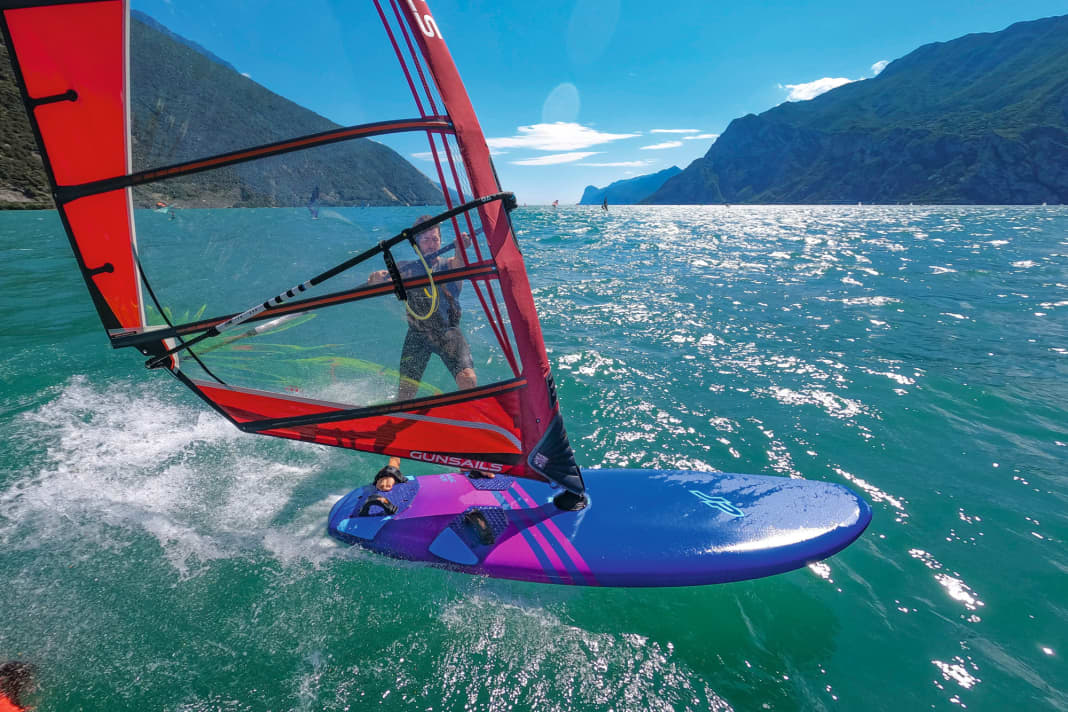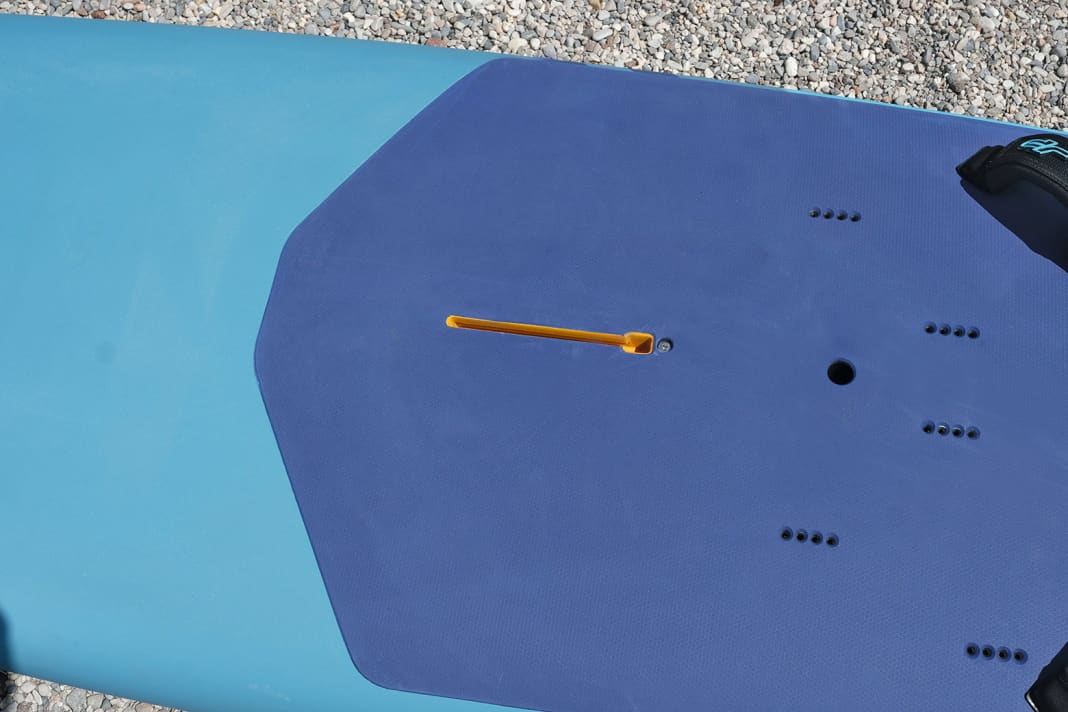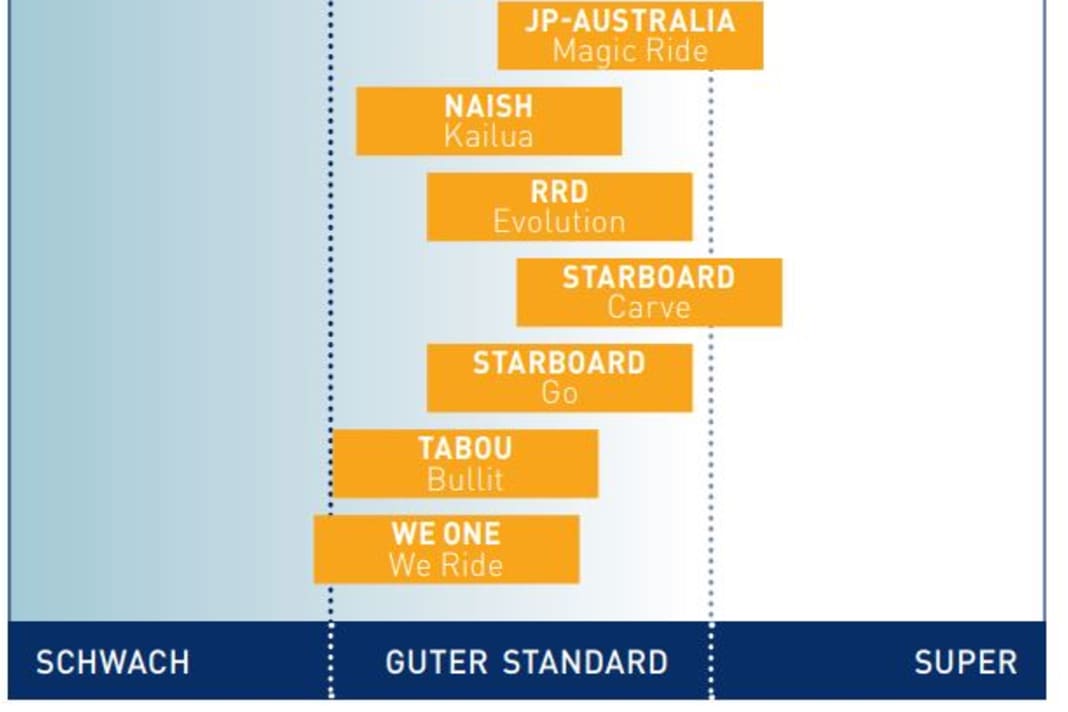Freeride 160 litres: Eleven boards for intermediates and light wind tested
Surf Testteam
· 24.08.2023






These boards are included in the test
click to go to the individual boards
This test group is like Haribo's colourado mix. There's hardly anyone who can't find at least one or two pieces that they can't resist, and there are pieces that remain until the end. And then there's someone who just loves these brown liquorice sandwiches. You can imagine the test group in a similar way. A mixture of boards that you can get on straight after the beginner's course and, in between, boards that even experienced freeriders will be happy to add to their fleet permanently. You can find a rough pre-sorting as a type recommendation at the end of this text. In addition to a suitable board model, the right size is at least as important for quick and effortless learning progress.
The right volume for windsurfing beginners
The biggest obstacle to quick learning success is often boards that are too small. Especially for beginners and in light planing winds, a few extra litres won't do any harm at all. For longboards with a daggerboard, such as the Naish Kailua, the Volume approximately your body weight in kilos plus 80 to 110 litres . With a volume of 160 litres, the Kailua in the test is therefore well suited for intermediates up to around 80 kilos - especially as a light wind cruiser. The board is available in other sizes up to 250 litres, with a full 3.19 metres in length, and is therefore suitable for significantly heavier intermediates and even as a board for windsurfing beginners with no previous experience.
Beginners definitely need a daggerboard or centre fin and should have at least 100 litres more volume than your own body weight calculate. For boards focussing on planing surfing (such as the Goya Volar, JP Magic Ride, Fanatic Eagle or Starboard Carve in the test), we use the volume a little more sparingly: Your body weight plus around 50 to 80 litres should be enough here. If in doubt, however, go for a larger board, as a little more volume and width is better than too little for your first attempts at gliding. Beginners are therefore better off adding the upper 80 litres. Experienced freeriders - even in light winds and with large sails - can usually manage with a volume plus 50 litres to their body weight.
For experienced surfers who use very large sails (over 7.5 square metres), the board width is the much more important factor. For example, a board for a 7.5 square metre sail should not be narrower than 75 centimetres; for 8.5 square metres, 80 to 85 centimetres are a good fit.
Even more topics for windsurfing beginners
Fin and weight of the boards tested
Some of the boards differ significantly in terms of construction, which is reflected in their weight and price. The differences are not visible from the outside. Whether more carbon, wood and PVC boards or simply more fibreglass is used on the inside makes the difference. If you expect maximum performance and the earliest possible planing, a lighter construction will always give you a noticeable advantage. Experience has shown that a board like the Goya Volar with two kilos less weight will easily outperform an RRD Evolution in terms of planing performance and also noticeably increase its speed potential. In terms of equipment, the straps and footpads are consistently of a high standard, and the fins supplied also work perfectly. The Naish fin is very short at 32 centimetres, with a larger fin the freeride suitability should increase considerably. On the other hand, the 52 cm fin on the JP Magic Ride helps with planing, levelling and bobbing, but freeriders can try a 48 cm fin for more top speed with sails under 8.5 square metres.
Knock-out criterion Loop positions
No matter what type of board you choose, the possible strap positions should suit you and already reveal whether a board is suitable in principle. Four straps mounted far out are only suitable for performance riders with freeride experience. Most intermediates will quickly get to grips with a four-loop set-up further inwards, such as the Fanatic Eagle or JP Magic Ride, because on modern boards with wide tails there is still enough space between the loop and the edge to slip in, even with two loops at the back. A triple configuration, with the front straps almost in the centre of the board and only one middle strap at the back, is only needed for the first attempts at planing or on boards that can move in a semi-planing state in light winds, such as the JP Fun Ride, Naish Kailua or Tabou Bullit. During the test, we mounted the straps far out on one side and further in on the other, as you can see in the photos. This is how we test how comfortable the standing position is in both positions - which turned out to be very pleasing in this group.
Features and details Freerideboards 160






There are even more detailed pictures of all the boards in the individual ratings!
Daggerboard, centre fin or blank
Only Naish offers the classic folding centreboard in this range. It folds in when you touch the ground and is always ready for planing with the daggerboard folded in when the wind drops. The difference when going upwind compared to a board without a daggerboard is like hiking 500 metres uphill or taking the chairlift. The disadvantages are the higher weight, the knob on deck and the somewhat slowing effect when planing. JP-Australia and Tabou therefore rely on an additional centre fin in a power box. In light winds and for kids, it can make sense to mount the longer fin in the centre. For planing surfing, the centre box is closed with an adapter.
Type recommendation
- Experienced freeridersThose looking for a board for large sails and light winds will find high-performance boards with excellent planing potential in the Fanatic Eagle and Fanatic Blast, JP-Australia Magic Ride and Starboard Carve and even the RRD Evolution. The Blast is already scratching the boundaries of the freerace class and is available in sizes no larger than 147 litres.
- Upgrading after completing a basic course - and perhaps a few extra hours of practice - have the largest selection in this test. Only the Fanatic Blast falls out due to its exclusively sporty strap positions and the Fanatic Eagle, Starboard Carve and We One at least don't offer any pure upwind positions. The Naish Kailua is a classic centreboard, especially if your area rarely offers planing wind. The JP-Australia Fun Ride and Tabou Bullit are more modern, yet very similar upwind concepts, which focus more on getting into planing surfing but still stand out from the pure freeride boards thanks to their greater length and additional centre fin. The Goya Volar, JP Magic Ride, RRD Evolution and Starboard Carve are largely classic freeride shapes with all the important strap options. If you choose these boards in the right size, you are guaranteed to get started with glide surfing.
- Who is a Family and children's board ideally go for a board with a large deck pad that protects children's skin from abrasions. RRD offers this at least at the rear, while the carpet is more generously laid on JP Fun Ride, Starboard Go and of course Naish Kailua.
Freerideboards 160 in comparison






All boards in the individual evaluation
click to go to the individual boards

